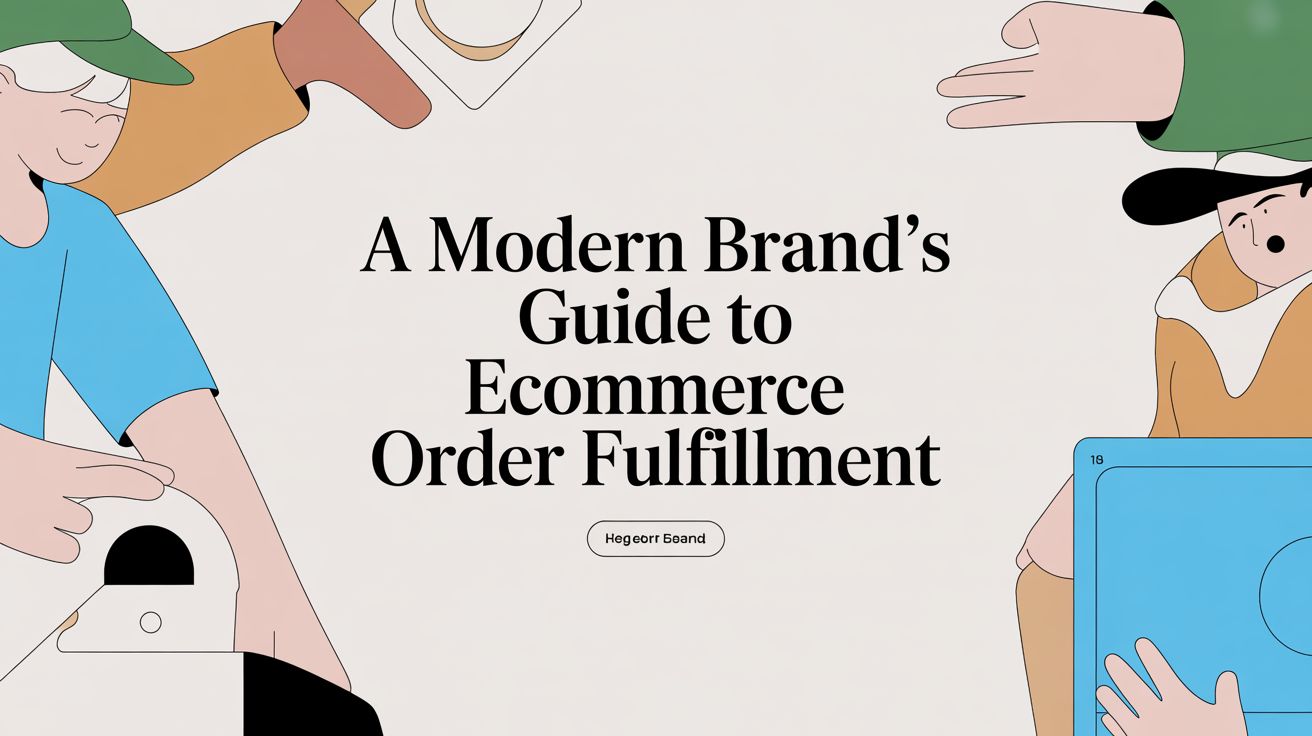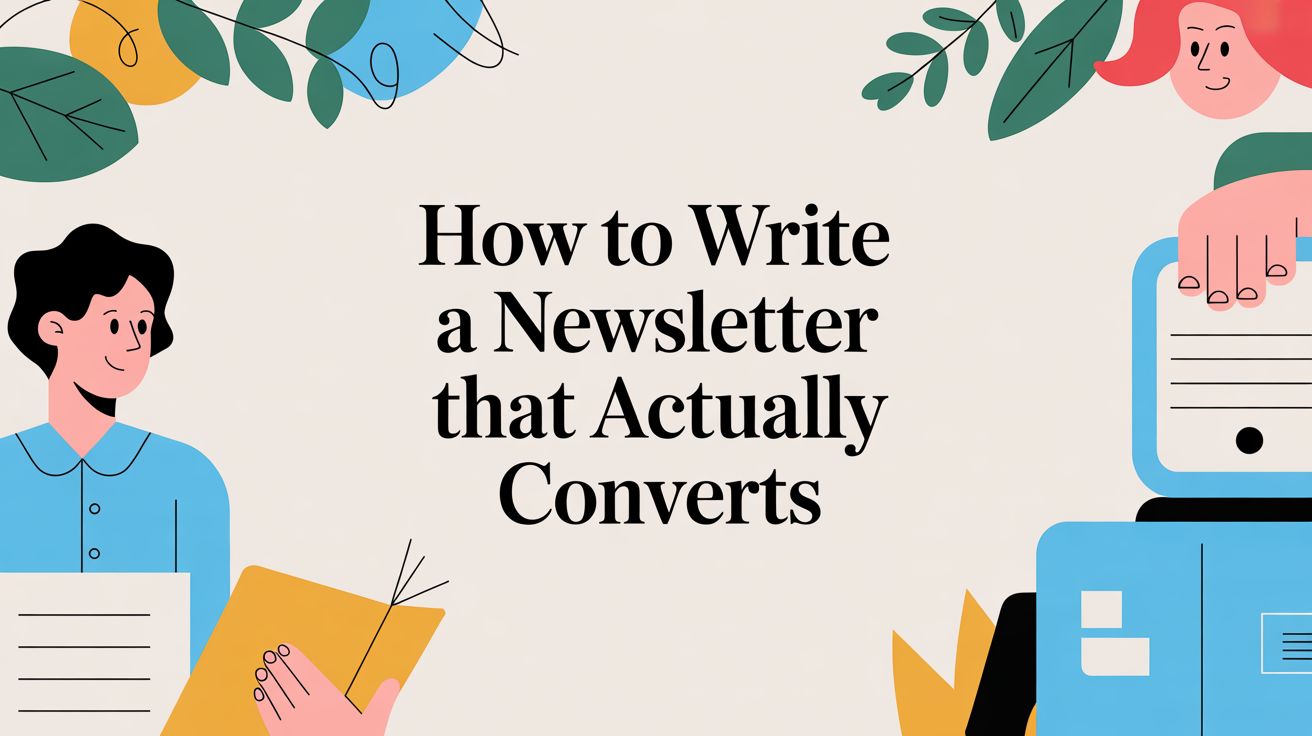
A Winning Black Friday Marketing Strategy
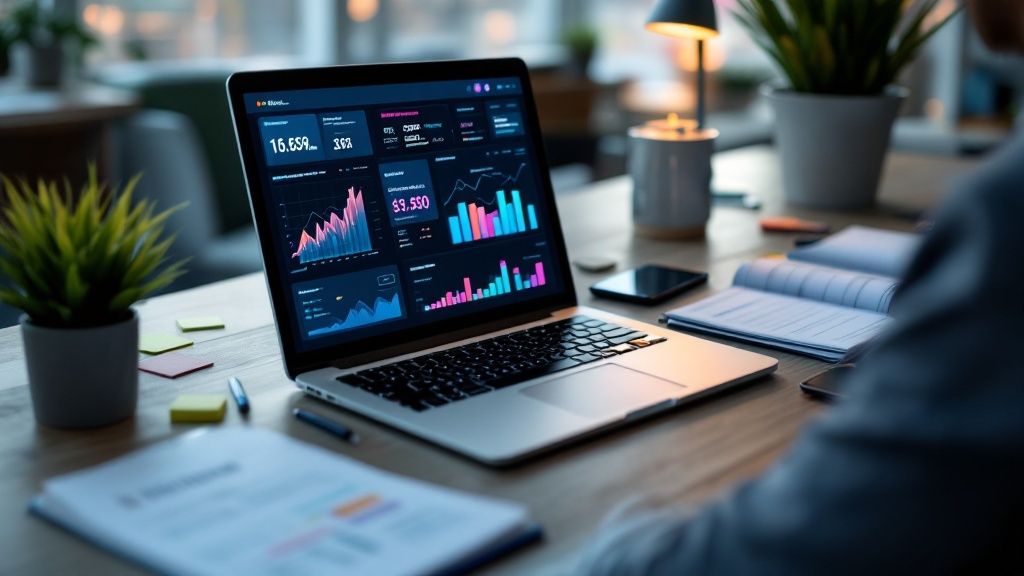
An effective Black Friday marketing strategy is built on more than just deep discounts; it's grounded in a sophisticated understanding of consumer psychology.
To drive immediate revenue and protect profit margins, brands must move beyond basic timers and pop-ups. The key lies in leveraging smarter behavioral triggers—principles like scarcity, social proof, and anticipation—to create compelling, high-impact purchasing moments.
The Science Behind High-Impact Urgency Marketing
A truly effective Black Friday strategy is grounded in behavioral economics, not just markdowns. The average e-commerce site sees a staggering 70% cart abandonment rate and a conversion rate that barely scrapes by at 2.5%. Brands that understand the science of urgency, however, can significantly outperform these benchmarks.
The goal isn't just to sell more; it's to sell smarter. A sophisticated urgency marketing strategy increases average order value (AOV) and helps clear key inventory without resorting to brand-damaging discounts that erode profits.
This means graduating from the simple tactics everyone else is using. A basic countdown timer might create a vague sense of urgency, but it often feels impersonal and generic, failing to connect with today's personalization-savvy shopper. Most pop-up apps are designed for one thing—email capture—completely missing the opportunity to convert a high-intent shopper and generate immediate revenue.
Moving Beyond Basic Timers and Pop-Ups
The real business impact comes from sophisticated execution. A generic timer shouts, "this deal ends soon," but a campaign built on behavioral triggers creates a unique "urgency moment" for an individual shopper. It's where psychology and technology meet to create scenarios that are genuinely compelling.
This advanced approach is rooted in core psychological principles:
- Scarcity: Highlighting limited stock on a popular item taps into a consumer's deep-seated desire for exclusivity. According to research on commodity theory, perceived scarcity increases an object's value, making it a powerful driver of immediate action.
- Anticipation: Building genuine excitement for an upcoming product drop or a special sale for your VIPs creates pent-up demand. When the offer goes live, customers who have been waiting are primed and ready to buy.
- Social Proof: We are wired to follow the crowd. Showing how many other people have just bought an item or are viewing it right now reduces purchase anxiety and validates the shopper's choice, a concept known as informational social influence.
- FOMO (Fear of Missing Out): Crafting offers that are not just time-sensitive but also feel exclusive creates a powerful motivation to act now. This taps into loss aversion, where the pain of missing out is a stronger motivator than the pleasure of gaining.
When you ground your tactics in these triggers, your marketing stops feeling like a gimmick and starts becoming a sophisticated strategy. To really go deep on this, check out these insights on the psychology of urgency marketing.
Actionable Takeaway: Ditch the generic "24-hour flash sale." Instead, try creating a dynamic offer on a specific product that only unlocks after a customer has viewed it twice. This is a behaviorally-triggered "moment" that feels personal and targets someone who is already showing high intent. For Shopify merchants, this can be automated to drive actual revenue, not just collect another email.
Adopting this kind of scientific approach doesn't just boost your Black Friday conversion rates; it elevates the entire customer experience. Platforms like Quikly are built for this, integrating with your Shopify store and tools like Klaviyo to automate these sophisticated moments. It’s how you turn psychological principles into predictable revenue and serious ROI.
Building Anticipation Before Black Friday Hits
The most profitable Black Friday campaigns don’t just appear on Thanksgiving. They begin weeks, even a month, in advance. This isn't just about running a sale; it's about turning a one-day event into a multi-week experience that builds genuine excitement. This pre-launch window is your golden opportunity to rise above the noise and get your audience laser-focused on your brand.
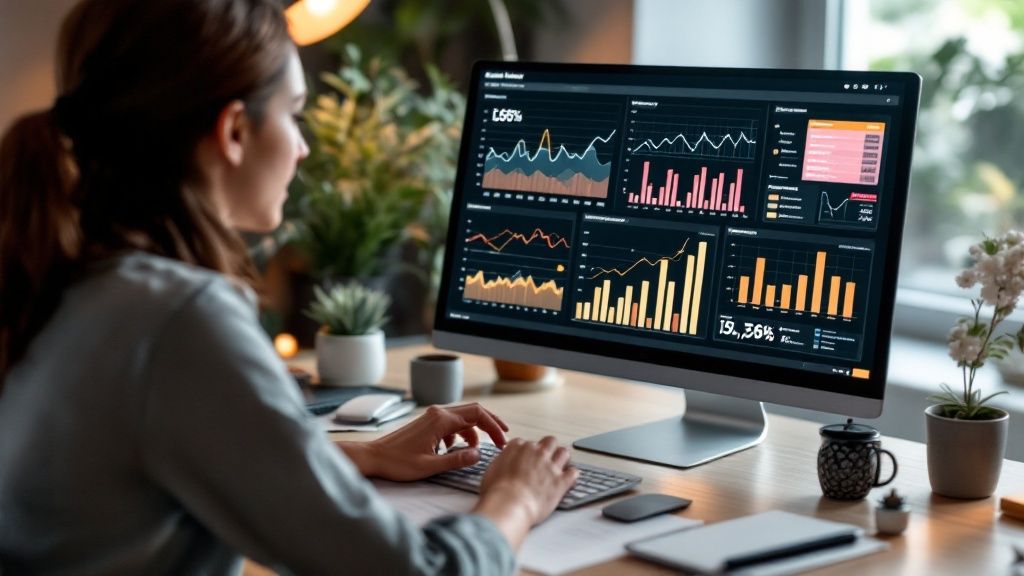
This entire strategy is rooted in a powerful psychological trigger: exclusivity. When people feel like they are part of an inner circle, their loyalty deepens and their desire to purchase increases. The goal is to make them feel like insiders getting a special advantage—a motivator far more powerful than any generic email popup.
Crafting Your VIP Early Access List
First, you need to build an exclusive VIP list. This isn't just about adding names to your main email or SMS database. It's about creating a separate, high-intent segment you can communicate with directly when it matters most.
You can accomplish this using the tools you already have. For Shopify merchants, this means ensuring your store is tightly integrated with platforms like Klaviyo or your preferred SMS tool.
- Build dedicated signup forms: Design pop-ups, flyouts, or embedded forms specifically for “VIP Early Access.” Make the value proposition crystal clear: sign up now to get Black Friday deals before everyone else.
- Run targeted social ads: Drive traffic from social campaigns straight to a landing page built for VIP signups. Use copy that creates urgency, like, "The deals are coming. Get on the list to be first in line."
- Segment like you mean it: As people sign up, immediately add them to a “Black Friday VIP 2024” list or tag in Klaviyo. This ensures your teasers only reach this engaged group, making the experience feel truly exclusive.
This process does more than just collect contacts; it builds a pre-qualified revenue stream of shoppers who have explicitly raised their hands in interest.
Actionable Takeaway: Use social proof in your signup messaging. Try something like, “Join over 10,000 shoppers who have already signed up for exclusive early access.” It taps into herd mentality and creates a fear of missing out (FOMO) that drives even more signups and demonstrates the authority of your brand.
Deploying a Strategic Teaser Campaign
Once your VIP list is growing, it’s time to nurture that excitement with a strategic content calendar. The key here is to tease, not reveal. You want to provide just enough information to build hype without showing all your cards too early.
Here’s what a multi-channel teaser campaign could look like:
- 3 Weeks Out: Announce the VIP list to your general audience. Send out an email and SMS blast inviting them to join the exclusive group for “our biggest sale of the year.”
- 2 Weeks Out: Send a “sneak peek” email only to the VIPs. This could be a blurred-out photo of a new product or a hint about which product categories will have the deepest discounts.
- 1 Week Out: Ramp up the frequency. Use Instagram or TikTok stories to show behind-the-scenes glimpses of your team preparing for the sale. Send an SMS to VIPs revealing the exact day they’ll get their early access link.
This methodical build-up creates more than just awareness; it fosters an emotional investment in your brand.
To successfully plan for peak sales periods like this, a comprehensive holiday promotion checklist for e-commerce brands can be a critical asset. You can also dive deeper by reading this extensive guide to consumer anticipation. By understanding these dynamics, you can transform Black Friday from a chaotic discount free-for-all into a structured, high-return campaign fueled by genuine excitement.
How to Structure Offers to Protect Your Margins
A blanket 40% off sitewide discount might send traffic soaring, but it's also a fast track to destroying your profitability. A truly intelligent Black Friday marketing strategy isn’t about who can slash prices the deepest; it’s about crafting offers that feel irresistible while protecting your margins and, ideally, boosting your Average Order Value (AOV).
The secret is to get out of the discount-only mindset and tap into consumer psychology. Instead of a generic sale that devalues your entire brand, you can build targeted promotions that feel exclusive and genuinely valuable. This isn't just about safeguarding profits—it's about making customers feel like they're getting a special deal from a premium brand, not just picking through a bargain bin.
Moving Beyond Sitewide Sales
Rethinking your discount strategy must start with data. Before you do anything else, dive into your Shopify analytics. Pinpoint your best-sellers and, just as importantly, your slow-moving inventory. This analysis is where strategic opportunities are found.
One of the most effective strategies is product bundling. You take a high-demand hero product and pair it with a complementary item that isn't moving as quickly. For example, a skincare brand could bundle its best-selling vitamin C serum with a slow-moving facial roller. To the customer, the perceived value of that bundle is huge. For the business, you're clearing out stagnant stock and bumping up the total transaction value.
This is a world away from a simple 10% off pop-up. It's a calculated move to lift AOV and manage inventory, directly impacting your bottom line revenue and profit margins.
Implementing Tiered and Dynamic Offers
Another powerhouse tactic is the tiered discount. This approach directly incentivizes customers to spend more to save more. It’s a classic psychological hook that plays on our desire for goal attainment; shoppers get a small thrill from hitting that next discount level.
A tiered structure could look something like this:
- Spend $75, get 15% off
- Spend $125, get 25% off + free shipping
- Spend $200, get 30% off + a free gift
This structure naturally guides customers to add just one more item to their cart, pushing your AOV higher while you maintain control over your margins. For merchants on Shopify Plus, tools like Shopify Scripts can automate these complex discount rules right at checkout, ensuring a frictionless experience even with massive enterprise-level volume.
You might be wondering where you should spend your marketing dollars to promote these kinds of offers. This breakdown gives a clear picture of a typical budget allocation.
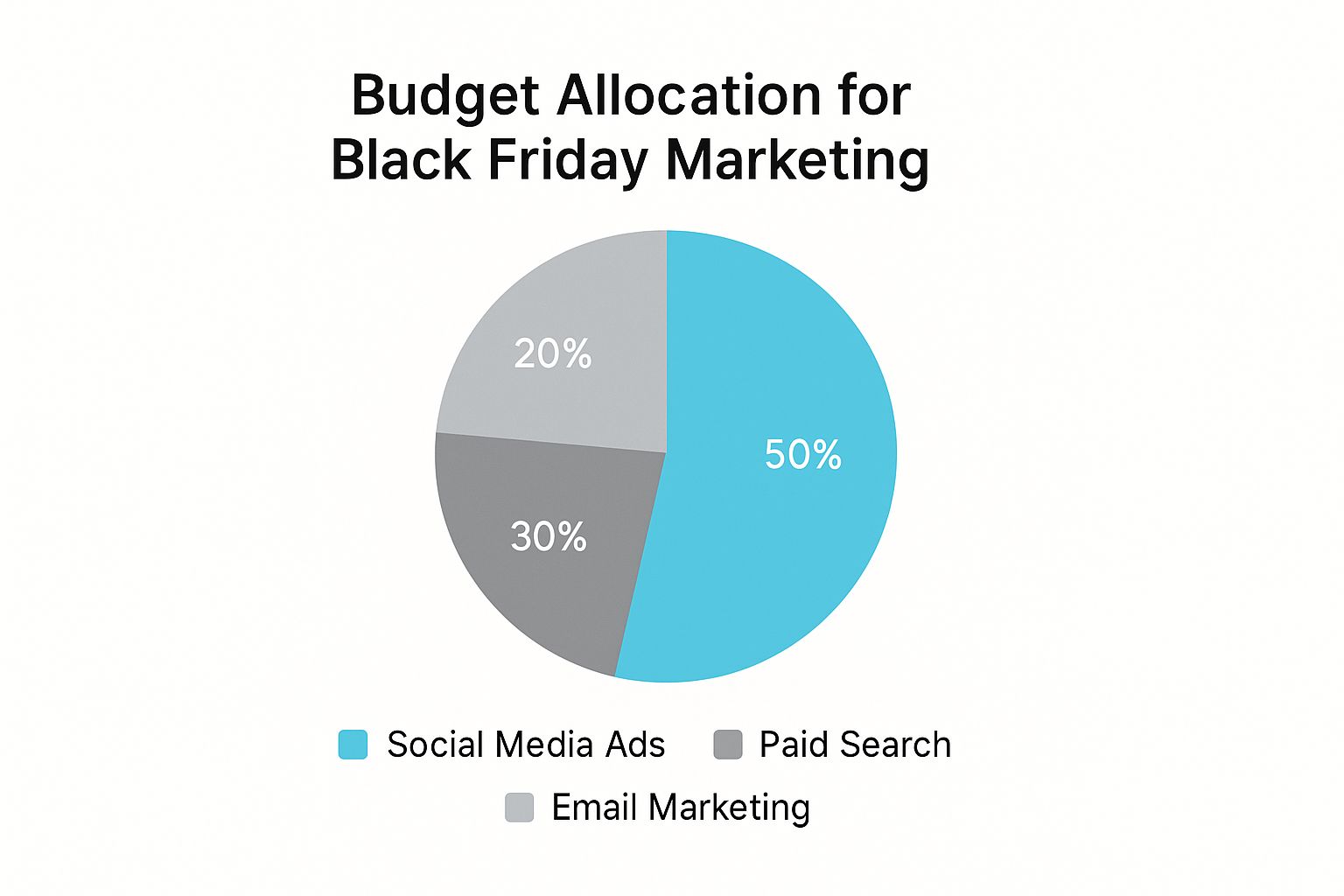
With a significant portion of the budget going toward paid channels, it becomes absolutely critical that the offers you're promoting are built for maximum profitability from the start.
Deciding on the right offer structure can be overwhelming. This table compares the most common approaches and their direct impact on your business's ROI.
Comparing Black Friday Offer Structures for ROI
| Offer Type | Impact on AOV | Margin Protection | Inventory Management Benefit |
|---|---|---|---|
| Blanket % Off | Neutral to Low | Low | Poor; indiscriminately discounts all products. |
| Tiered Discount | High | Medium | Good; encourages higher spending on all items. |
| Product Bundle | High | High | Excellent; pairs best-sellers with slow-movers. |
| Gift with Purchase | Medium to High | High | Good; gift is often a lower-cost or surplus item. |
| Category Sale | Low | Medium | Good; isolates discounts to specific product types. |
As you can see, moving away from simple sitewide sales gives you far more strategic control over your margins and inventory. The goal is to make the customer feel like they are getting an amazing deal, which doesn't always have to mean the biggest percentage off.
Key Insight: The goal is to shift the customer mindset from "How much can I save?" to "How much value can I get?" A gift-with-purchase or a well-crafted bundle often provides more perceived value than a simple percentage discount, yet it costs your business far less.
Finally, don't overlook the power of dynamic, limited-quantity flash sales on specific products. Unlike a sitewide sale, a flash sale on a single SKU creates genuine, undeniable scarcity. Using a platform like Quikly, you can create behavior-driven "Moments" where only a handful of items are released at a compelling price. This drives intense, focused buying frenzies without devaluing the rest of your catalog. It's a surgical approach to urgency that protects brand equity and maximizes revenue.
While the average global discount rate during Black Friday hovers around 26%, some categories like apparel and skincare often see discounts of 33–40%. This just underscores the need for these more refined, margin-protecting strategies. If you're in a competitive space, you can't afford to just give away profit. Discover more insights about these refined category-level discount strategies.
Executing a Multi-Channel Campaign That Converts
An elite Black Friday marketing strategy requires more than just a great offer; it demands flawless execution across every channel where your customers are active. Blasting the same generic message across email, SMS, and social media is a surefire way to burn through your ad budget with minimal ROI.
The real impact comes from a cohesive, multi-channel campaign that understands the unique psychology of each platform and funnels customers toward a single, clear goal: driving revenue.
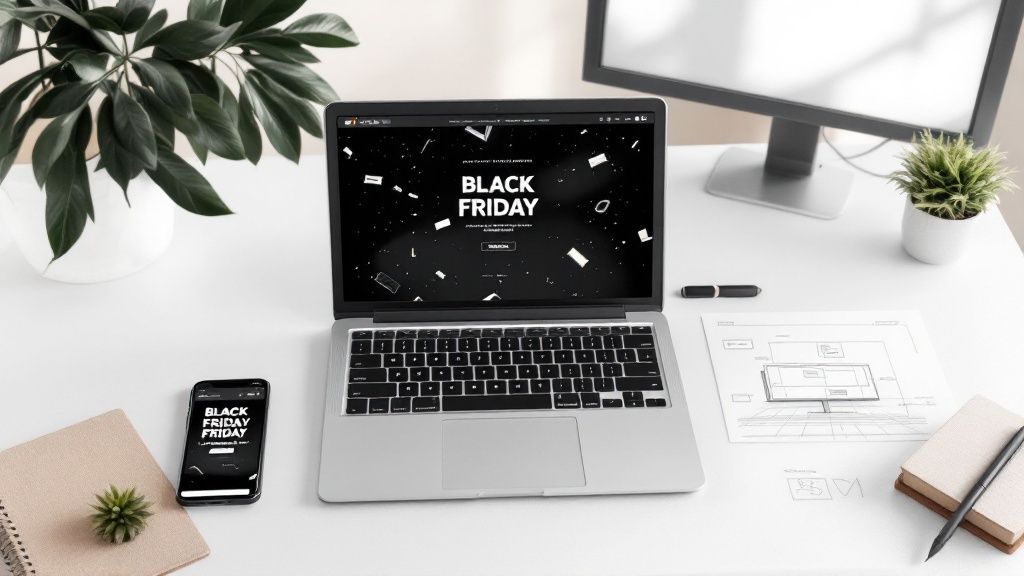
This is a world away from fragmented, manual efforts. We're talking about using sophisticated automation to create a seamless journey that feels both personal and urgent—a journey that guides a shopper from a social media ad, straight to a Shopify product page, and through checkout without friction.
Tailoring Your Message for Each Platform
Consider your customers' mindset. Someone scrolling through Instagram is in discovery mode, but a customer who has opted into your SMS list is ready for a direct, actionable deal. Your strategy must respect that difference.
Email Marketing (The Storyteller): This is your space for longer, story-driven promotions. Use email to build anticipation for upcoming drops, share curated gift guides, and segment your lists for hyper-personal offers. For instance, you could use your Klaviyo integration to send a beautifully designed email to your VIPs, giving them a sneak peek at a premium bundle that's about to go live.
SMS Marketing (The Activator): When you need immediate action, SMS is your direct line. Its high open rates make it the perfect tool for high-urgency alerts. Think flash sale notifications ("Only 100 units left! Deal drops in 5 minutes.") or exclusive, time-sensitive coupon codes that disappear in a couple of hours.
Social Media (The Discovery Engine): Platforms like Instagram and TikTok are all about visual discovery. This is where you run your eye-catching video content, user-generated content campaigns, and scroll-stopping ads. Your call-to-action needs to be simple and direct, leading to one specific, optimized landing page.
Paid Ads (The Precision Tool): Use Google and social ads for surgical strikes. Retarget shoppers who abandoned their carts with dynamic ads that show them the exact products they left behind. It’s about precision, not just reach. Every dollar should be spent converting shoppers who are already showing high intent.
This isn't just making noise; it's creating a symphony of touchpoints that all work in harmony. Getting this right is a huge piece of the puzzle, and you can dive deeper in our guide on what marketing channels work best together.
Integrating a Seamless Mobile-First Journey
The Black Friday battlefield is overwhelmingly mobile. An incredible 75.2% of sales in 2024 happened on a mobile device. That statistic is a clear mandate: your campaign must be flawless on a small screen, from the first ad they see to the final checkout confirmation.
For Shopify merchants, this is non-negotiable. Your theme must be fully responsive, and you need to have one-click payment options like Shop Pay enabled. A clunky, slow mobile experience is the fastest way to lose a sale and render your campaign efforts useless.
Real-World Scenario: A Tale of Two Strategies
The Fragmented Approach: A brand runs a generic "20% off" ad on Instagram. A user clicks, gets dumped on the homepage, and now has to hunt for the product. They add it to their cart but get distracted. An hour later, a generic abandoned cart email lands in their inbox. All the momentum is gone.The Cohesive & Automated Approach: A brand uses Quikly to announce a limited-quantity drop via SMS and a targeted Instagram ad. A user clicks the ad and lands directly on the product page, where a live counter shows the inventory dwindling. They add it to their cart, and thanks to a Shopify Plus integration, checkout is just a single tap. The entire journey is seamless and urgent, creating a powerful conversion engine that drives a massive lift in revenue.
The Power of Sophisticated Automation
The difference between those two scenarios isn't the offer—it's the strategy and technology powering the execution. Basic pop-ups and timers just can't pull this off. They're static tools trying to compete in an incredibly dynamic environment.
An advanced urgency marketing platform, on the other hand, acts as the central nervous system for your entire campaign. It plugs into your existing marketing stack (think Klaviyo, Attentive, etc.) to trigger behavior-based "Moments" across every channel. This is the next evolution of urgency marketing—moving beyond a simple countdown timer on a page to fully automated, multi-channel events that deliver predictable ROI and protect your precious profit margins.
Using AI and Personalization for a Competitive Edge
In the chaos of Black Friday, generic marketing no longer cuts it. Your customers are drowning in a sea of offers, and if your message isn't speaking directly to them, it's being ignored.
A truly competitive strategy must go beyond simply using a customer's first name in a subject line. It requires creating one-to-one experiences that feel genuinely helpful and hyper-relevant. This is where AI-driven personalization stops being a "nice-to-have" and becomes a core component of your revenue-generating toolkit. It's the difference between shouting into a crowd and whispering the perfect suggestion to a single shopper.
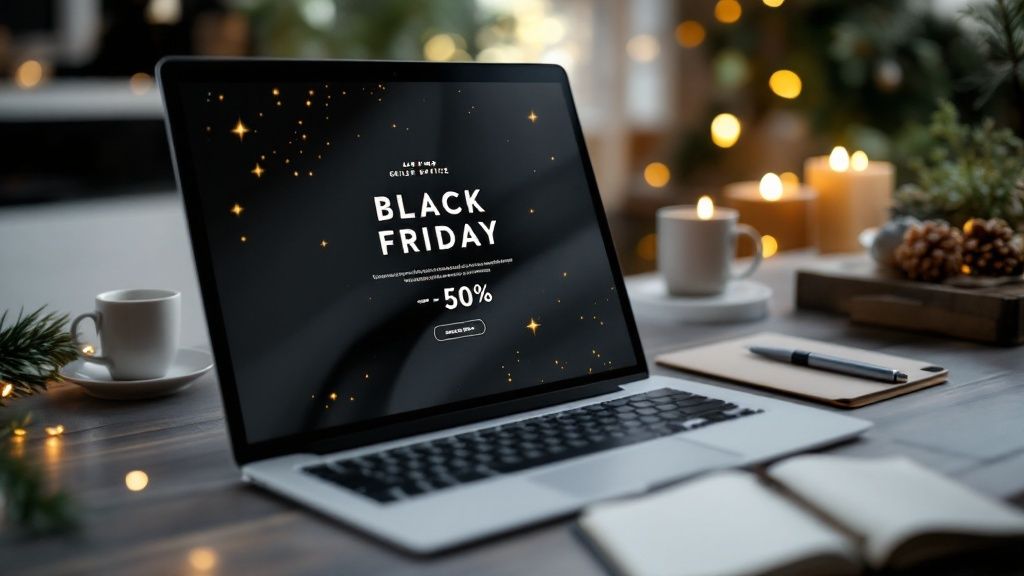
Beyond Basic Email Pop-Ups
For years, the go-to tactic was a simple email pop-up flashing a discount. While that's fine for list building, it does very little to convert a high-intent shopper who's on your site right now and ready to buy.
Today's technology allows for a much smarter approach. Instead of a static pop-up that merely interrupts the experience, intelligent platforms can trigger what we call "Moments." These aren't just pop-ups; they're dynamic, personalized experiences served up based on what a user is doing in real time. The goal is to assist the customer journey, not hijack it, turning browsing into revenue.
Think of a "Moment" as a special, limited-time offer that appears only after a user has viewed the same product three times in one session. That's not a random discount. It's a strategic, psychology-backed nudge based on clear interest, turning a hesitant browser into a confident buyer.
AI-Powered Recommendations and Offers
When you bring AI into the mix, you can start analyzing huge amounts of customer data—past purchases, browsing history, cart contents—to predict what a shopper will want next. For Black Friday, this is a total game-changer for ROI.
Here's how it plays out:
- Dynamic Product Recommendations: Forget showing everyone the same "best-sellers." AI can display products that truly complement what’s already in a customer's cart. A Shopify Plus store, for instance, can integrate this to personalize the shopping experience on the fly.
- Personalized Offers: Ditch the sitewide discounts that eat into your margins. AI allows you to generate unique, single-use discount codes for specific customer segments, rewarding loyalty or targeting high-value shoppers.
- AI-Driven Chatbots: A well-trained chatbot can act like a personal shopper, guiding customers to the best deals, answering questions instantly, and even processing orders. This frees up your human support team while giving every visitor a high-touch experience.
The impact is real and measurable. Research shows that marketing campaigns using AI-powered personalization influenced 54% of shoppers. We've also seen chatbots increase conversion rates by nearly 9%. These aren't just vanity metrics; they're direct boosts to your bottom line.
Actionable Implementation on Shopify
For Shopify merchants, integrating these advanced tools is more accessible than ever. By connecting your store to platforms like Quikly, you can automate these sophisticated strategies without needing a dedicated team of data scientists.
Picture this: a customer who bought running shoes from you last year visits your site. An automated system has already tagged them for a special offer. Instead of seeing the generic homepage banner, they're greeted with a personalized hero image featuring new athletic apparel and an exclusive early-bird discount. That's the level of detail that sets market leaders apart.
To really get a handle on how this technology can reshape your customer interactions, it's worth exploring the benefits of AI for customer engagement. When your marketing feels less like a bullhorn and more like a concierge service, you create a memorable experience that builds loyalty long after the Black Friday rush is over.
Post-Sale Analysis and Retargeting for Future Growth
Once the last Black Friday order has shipped, the work isn't over—it’s just shifting into a new, incredibly important phase. The data you just collected and the customer relationships you just initiated are two of your most valuable assets for long-term growth.
A smart Black Friday strategy doesn't end with the sale. It pivots from acquisition to retention, focusing on how to turn those seasonal shoppers into profitable, year-round customers. Skipping this step is a significant missed opportunity. You invested a substantial portion of your budget to acquire these customers; now is the time to maximize their lifetime value.
Analyzing Performance Beyond Revenue
That top-line revenue number is a great start, but true business impact is found deeper in your analytics. To get a true sense of performance, you must analyze profitability and efficiency, moving beyond surface-level metrics.
Here are the key metrics to scrutinize for ROI:
- Customer Acquisition Cost (CAC) by Channel: Did your paid social ads deliver a lower CAC than your email campaigns? Knowing this helps you shift your budget for the next major sales event. It's about working smarter, not just spending more.
- Average Order Value (AOV) by Offer Type: How did product bundles perform against tiered discounts? Did one strategy do a better job of lifting AOV? This data is invaluable for structuring future promotions that not only drive sales but also protect your margins.
- Profit Margin per Order: After subtracting discounts, ad spend, and shipping costs, which campaigns were actually the most profitable? A high-revenue campaign with razor-thin margins might not be worth repeating.
This kind of analysis is what separates brands that just run sales from those building a predictable, profitable marketing engine. If you're on a platform like Shopify Plus, you can leverage advanced analytics tools to automate much of this and get a clear picture of what truly drove your ROI.
Expert Insight: The biggest mistake brands make is treating Black Friday as an isolated event. The data you collect—what offers converted best, which channels drove the most profitable customers—is a detailed roadmap for your entire next year of marketing.
Segmenting New Customers for Long-Term Loyalty
Your list of new customers is not a monolith. It's a collection of different personas with different motivations. The first step is to start segmenting them. This sets you up for effective, personalized follow-ups that build real loyalty and prevent them from becoming one-time buyers.
Consider these simple, high-impact segments:
- High-AOV Customers: These are your new VIPs. Enroll them into an exclusive email flow immediately that offers early access to new products or special perks. They’ve already shown a willingness to spend more.
- Single-Item Buyers: These customers likely jumped on a specific deal. Retarget them with ads that showcase complementary products. For example, if they bought a coffee maker, your next ad should be for premium beans or mugs.
- Discount-Driven Shoppers: This group was motivated by your steepest discounts. Nurture them with value-focused content and smaller, margin-friendly offers to keep them engaged without eroding your profitability.
Activating Retargeting and Nurture Campaigns
Once your segments are defined, it’s time to activate your follow-up campaigns. By integrating your Shopify store with tools like Klaviyo or your favorite SMS platform, you can automate these personalized journeys.
Think about creating a "New Black Friday Customer" email flow. It could start with a simple thank-you message, followed by an email sharing your brand's story, and then another one offering a small incentive for a second purchase. This isn't about hammering them with another sale immediately; it's about building a relationship and reinforcing their decision to buy from you.
By putting a real focus on post-sale analysis and strategic retargeting, your Black Friday efforts transform from a short-term revenue spike into a sustainable engine for growth. You don't just gain sales; you gain intelligence and loyal customers who will keep driving revenue for months and years to come.
Ready to transform your marketing from basic timers to sophisticated, psychology-driven campaigns? See how Quikly can help you build urgency moments that drive predictable revenue and turn shoppers into loyal customers. Discover the Quikly platform today.

The Quikly Content Team brings together urgency marketing experts, consumer psychologists, and data analysts who've helped power promotional campaigns since 2012. Drawing from our platform's 70M+ consumer interactions and thousands of successful campaigns, we share evidence-based insights that help brands create promotions that convert.
